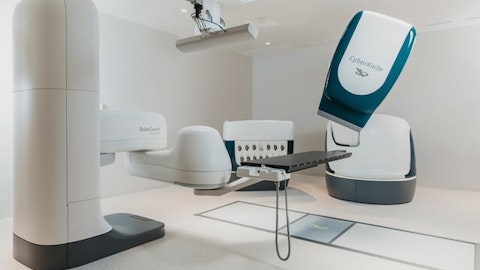Lucas Buchanan: Yeah. We didn’t mention on the call, because there really is no substantive update. Just as a reminder, TCAR is multiple products, which means multiple regulatory pathways across two different countries. It also means multiple reimbursement pathways, as well as the channel discussions and so we continue to make good progress on all those fronts as the markets themselves are dynamic and changing and so no substantive update this quarter, but continue to make progress.
Unidentified Analyst: Okay. Appreciate the color.
Operator: Please hold for our next question. Our next question comes from Neil Chatterji of B. Riley. Neil, go ahead with your question. Neil, go ahead with your question. Standby for our next question. Our next question comes from Adam Maeder of Piper Sandler. Adam, please go ahead with your question.
Adam Maeder: Hi. Good afternoon, Chas and Lucas. Thank you for taking the questions and Chas, congrats on the new role.
Chas McKhann: Thanks, Adam.
Adam Maeder: Maybe just to start, I wanted to double click a little bit more on the sales disruption issue and just understand kind of where are we today from a headcount standpoint? I mean I just — I heard the commentary in territories, but are you willing to give headcount? Where were we at the beginning of the year, do you have any territories that are understaffed or open? Just any more details you can share there would be appreciated? Thanks.
Lucas Buchanan: Sure, Adam. I will take that. So we exited 2022 with 70 territories, as you may remember, which was a similar spot where we were in Q2 and then Q3 80 and I just mentioned 85 on this call. And we are roughly a territory for us is one sales rep and one clinical specialist on average and then obviously we have a sales management layer in addition. And so, as we have been building and expanding this team over time, at any given point in time, we are doing territory splits. We are backfilling reps who have been promoted. There’s always normal attrition in open territories either because of attrition or promotion and so that’s kind of always happening in the background and over our entire commercial existence, but that’s where we stand today.
Adam Maeder: Okay. Thanks for the additional color there. And I guess the follow-up would be on the NCD that went into place last month. I am just curious what you are hearing from your customer base about the new carotid NCD, any kind of chatter that they may be sharing with you all? Have they seen any change to the referral pathway or volume trends? Thank you.
Lucas Buchanan: Yeah. I think there’s general excitement and I think physicians talking about this, referring physicians talking about this, companies and innovators talking about this, is all a good thing for the market as a whole. As I said in my prepared remarks, our position hasn’t changed. We think this as stated one of the goals by Medicare is to broaden access and we think this leads to more interest and awareness that could potentially have a market expansion effect over time. And we really are at the beginning after many years of putting TCAR on the map and the history of transfemoral carotid stenting prior to that at the era of minimally invasive carotid stenting, which has already happened in almost every other blood vessel, right?
And so we see the market expanding, we see minimally invasive product stenting procedures rising and invasive surgical procedures falling and we are the clear leader in the minimally invasive category, right, as measured by evidence, experience, products, broad label, commercial expertise and on and on. So we are excited about this next era.
Adam Maeder: Thank you.
Operator: Standby for our next question. Our next question comes from Kristen Stewart of CL King. Kristen, please go ahead with your question.
Kristen Stewart: Hi. Thanks for taking my question, and Chas, congratulations on the new role.
Chas McKhann: Thank you.
Kristen Stewart: I was wondering if you could just dive a little bit deeper into the expectations for 4Q to what extent there’s any sort of disruption that you would expect from the NCD embedded in your assumptions there?
Lucas Buchanan: Well, I think, it’s certainly a new variable, Kristen. So that’s something has to be considered for that, some of it is kind of where our commercial organization is, as I mentioned, and some of it is just making sure Chas has the time to really dig into the business as we close out the year.
Kristen Stewart: Okay. And then as a follow-up question, just on gross margins, they came in and improved sequentially. I was wondering if you could help us just take a step back and think about what sort of expectations we should see going forward?
Lucas Buchanan: Yeah. So it was a strong kind of clean quarter on the gross margin front relative to volume across our two manufacturing facilities that are fully operational and so we expect to continue getting some leverage out of that fixed overhead as we drive unit volumes up over the future. And we have also obviously continued to perform really well on the product level ASPs that, obviously, help underwrite that performance in the face of the supply chain cost inflationary pressures and other things that service headwinds.
Kristen Stewart: Okay. Thanks very much.
Lucas Buchanan: Thank you, Kristen.
Operator: One moment for our next question. Our next question comes from Suraj Khalia of Oppenheimer & Company. Suraj, go ahead with your question.
Suraj Khalia: Good afternoon, Chas, Lucas. Can you hear me all right?
Lucas Buchanan: Yes.
Chas McKhann: Yeah. Good afternoon, Suraj.
Suraj Khalia: Chas, congrats on the new role. Wish you all the best.
Chas McKhann: Thank you.
Suraj Khalia: So, Chas, I just — forgive me, I know you are new and this question might be unfair, but I just want to sort of tee off on your comments about doing due diligence on Silk. When you look back at your background with Apollo, Torax, so on and so forth, when such a structural shift happens, do you think it makes any sense to change sales force incentives either to reduce churn and/or improve utilization?
Chas McKhann: Okay. You are getting real detailed on me, Suraj. Look…
Suraj Khalia: Forgive me, I…
Chas McKhann: No. No. I appreciate the question. And let me just say, so, again, in the broader context, the commercial team here has done a fantastic job of growing the business since launch. And as we look at and learn from what’s happened this year, we are going to dig into all of that, right? We are going to spend time together looking at it collectively, and say, what are the various aspects that we need to? What do we build on that’s already in place that’s working great? What are some areas we may want to adjust and enhance going forward? But I am nowhere near being able to answer the question in terms of exactly what we might do until we have had a chance to do that. And so I really do look forward in the coming months to coming back to this group with much more of a forward-looking commentary on where we are heading, but first, we got to do the work.




